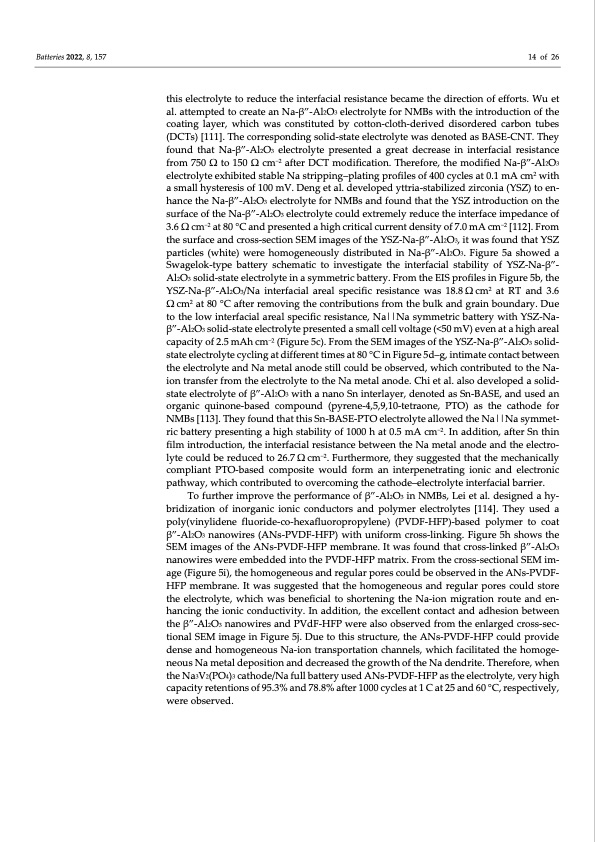
PDF Publication Title:
Text from PDF Page: 014
Batteries 2022, 8, 157 14 of 26 this electrolyte to reduce the interfacial resistance became the direction of efforts. Wu et al. attempted to create an Na‐β”‐Al2O3 electrolyte for NMBs with the introduction of the coating layer, which was constituted by cotton‐cloth‐derived disordered carbon tubes (DCTs) [111]. The corresponding solid‐state electrolyte was denoted as BASE‐CNT. They found that Na‐β”‐Al2O3 electrolyte presented a great decrease in interfacial resistance from 750 Ω to 150 Ω cm−2 after DCT modification. Therefore, the modified Na‐β”‐Al2O3 electrolyte exhibited stable Na stripping–plating profiles of 400 cycles at 0.1 mA cm2 with a small hysteresis of 100 mV. Deng et al. developed yttria‐stabilized zirconia (YSZ) to en‐ hance the Na‐β”‐Al2O3 electrolyte for NMBs and found that the YSZ introduction on the surface of the Na‐β”‐Al2O3 electrolyte could extremely reduce the interface impedance of 3.6 Ω cm−2 at 80 °C and presented a high critical current density of 7.0 mA cm−2 [112]. From the surface and cross‐section SEM images of the YSZ‐Na‐β”‐Al2O3, it was found that YSZ particles (white) were homogeneously distributed in Na‐β”‐Al2O3. Figure 5a showed a Swagelok‐type battery schematic to investigate the interfacial stability of YSZ‐Na‐β”‐ Al2O3 solid‐state electrolyte in a symmetric battery. From the EIS profiles in Figure 5b, the YSZ‐Na‐β”‐Al2O3/Na interfacial areal specific resistance was 18.8 Ω cm2 at RT and 3.6 Ω cm2 at 80 °C after removing the contributions from the bulk and grain boundary. Due to the low interfacial areal specific resistance, Na||Na symmetric battery with YSZ‐Na‐ β”‐Al2O3 solid‐state electrolyte presented a small cell voltage (<50 mV) even at a high areal capacity of 2.5 mAh cm−2 (Figure 5c). From the SEM images of the YSZ‐Na‐β”‐Al2O3 solid‐ state electrolyte cycling at different times at 80 °C in Figure 5d–g, intimate contact between the electrolyte and Na metal anode still could be observed, which contributed to the Na‐ ion transfer from the electrolyte to the Na metal anode. Chi et al. also developed a solid‐ state electrolyte of β”‐Al2O3 with a nano Sn interlayer, denoted as Sn‐BASE, and used an organic quinone‐based compound (pyrene‐4,5,9,10‐tetraone, PTO) as the cathode for NMBs [113]. They found that this Sn‐BASE‐PTO electrolyte allowed the Na||Na symmet‐ ric battery presenting a high stability of 1000 h at 0.5 mA cm−2. In addition, after Sn thin film introduction, the interfacial resistance between the Na metal anode and the electro‐ lyte could be reduced to 26.7 Ω cm−2. Furthermore, they suggested that the mechanically compliant PTO‐based composite would form an interpenetrating ionic and electronic pathway, which contributed to overcoming the cathode–electrolyte interfacial barrier. To further improve the performance of β”‐Al2O3 in NMBs, Lei et al. designed a hy‐ bridization of inorganic ionic conductors and polymer electrolytes [114]. They used a poly(vinylidene fluoride‐co‐hexafluoropropylene) (PVDF‐HFP)‐based polymer to coat β”‐Al2O3 nanowires (ANs‐PVDF‐HFP) with uniform cross‐linking. Figure 5h shows the SEM images of the ANs‐PVDF‐HFP membrane. It was found that cross‐linked β”‐Al2O3 nanowires were embedded into the PVDF‐HFP matrix. From the cross‐sectional SEM im‐ age (Figure 5i), the homogeneous and regular pores could be observed in the ANs‐PVDF‐ HFP membrane. It was suggested that the homogeneous and regular pores could store the electrolyte, which was beneficial to shortening the Na‐ion migration route and en‐ hancing the ionic conductivity. In addition, the excellent contact and adhesion between the β”‐Al2O3 nanowires and PVdF‐HFP were also observed from the enlarged cross‐sec‐ tional SEM image in Figure 5j. Due to this structure, the ANs‐PVDF‐HFP could provide dense and homogeneous Na‐ion transportation channels, which facilitated the homoge‐ neous Na metal deposition and decreased the growth of the Na dendrite. Therefore, when the Na3V2(PO4)3 cathode/Na full battery used ANs‐PVDF‐HFP as the electrolyte, very high capacity retentions of 95.3% and 78.8% after 1000 cycles at 1 C at 25 and 60 °C, respectively, were observed.PDF Image | Electrolyte Engineering for Sodium Metal Batteries

PDF Search Title:
Electrolyte Engineering for Sodium Metal BatteriesOriginal File Name Searched:
batteries-08-00157.pdfDIY PDF Search: Google It | Yahoo | Bing
Product and Development Focus for Salgenx
Redox Flow Battery Technology: With the advent of the new USA tax credits for producing and selling batteries ($35/kW) we are focussing on a simple flow battery using shipping containers as the modular electrolyte storage units with tax credits up to $140,000 per system. Our main focus is on the salt battery. This battery can be used for both thermal and electrical storage applications. We call it the Cogeneration Battery or Cogen Battery. One project is converting salt (brine) based water conditioners to simultaneously produce power. In addition, there are many opportunities to extract Lithium from brine (salt lakes, groundwater, and producer water).Salt water or brine are huge sources for lithium. Most of the worlds lithium is acquired from a brine source. It's even in seawater in a low concentration. Brine is also a byproduct of huge powerplants, which can now use that as an electrolyte and a huge flow battery (which allows storage at the source).We welcome any business and equipment inquiries, as well as licensing our flow battery manufacturing.| CONTACT TEL: 608-238-6001 Email: greg@salgenx.com | RSS | AMP |